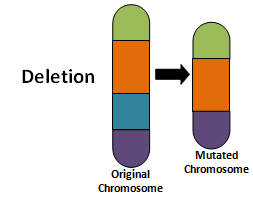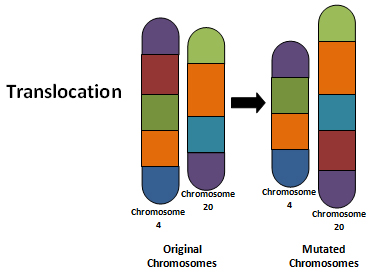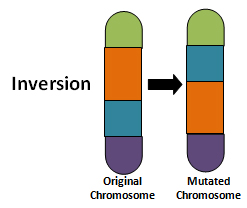Mutations and chromosomal disorders are two major drawbacks when it comes to genetic inheritance. Well, not everyone is born ideally, are they? Mutation and chromosomal disorder are different phenomena in genetics. Let us understand them in a bit more detail.
Suggested Videos
Mutation
A mutation can be defined as a slight change or alteration in the genetic material of an individual that brings about genetic diversity in the species. They can affect a small portion of the gene sequence or a large one. Mutations can be broadly classified into two types:
- Somatic or Acquired
These gene mutations can occur at any time during an individual’s lifetime. They are called acquired because they are acquired during one’s lifetime due to environmental factors like UV rays. They are called as somatic mutations because they occur in general body cells and not in those that produce the egg or sperm. Due to this, they cannot be inherited or passed on from one generation to another.
- Hereditary
As the name goes, these mutations can be passed on from one generation to the next. These mutations occur in the egg or sperm cells of the parent. When the two parental cells, one with mutation, unite, the resulting offspring is born with this mutation. This offspring will now have this mutation in all of its body cells.
Another kind of mutation that can occur is called as mosaicism. In this type of mutation, the parental germ cells have no inherent mutation in them. But, once the zygote begins to undergo multiple cell divisions, a mutation occurs. In this case, those cells that divide from the mutated cell or cells will have the mutation while the rest are clear of the mutation.
Browse more Topics under Principles Of Inheritance And Variation
You can download Principles of Inheritance and Variation Cheat Sheet by clicking on the download button below
Chromosomal Disorders
Unlike mutations that affect the genetic code, chromosomal disorders are caused by the change in number or structure of chromosomes. Both these give rise to different kinds of diseases.
Diseases Caused by Changes in Chromosomal Number
Humans normally have 46 chromosomes or 23 pairs of them. However, some babies are born with either less or more chromosomes than the required number giving rise to different conditions. Sometimes, a chromosome can get duplicated leading to a condition known as trisomy.
In other cases, a chromosome does not get duplicated leading to a condition called as monosomy. At times, the entire set of chromosomes get duplicated called as triploidy and if more than duplication would lead to polyploidy. Examples of diseases that are caused by changes in chromosomal number:
- Down’s syndrome: It is caused by trisomy of chromosome number 21. It is characterized by intellectual disability including mental retardation. They have lots of heart conditions and learning and growth disabilities as well.
- Turner’s syndrome: This syndrome occurs due to missing second sex chromosome and is written as XO. Characterised by both male and female genitalia, individuals born with this syndrome have mental disabilities and retarded sexual development.
- Klinefelter’s syndrome: This syndrome is characterized by an extra sex chromosome. These individuals are called ‘supermales’. The syndrome is represented as XXY where the individuals have an extra Y chromosome. The individuals with this syndrome have similar features like those with Turner’s syndrome but they are more aggressive and tend to have a criminal behaviour.
- Other syndromes are Edward’s syndrome(trisomy of chromosome 18) and Patau’s syndrome(trisomy of chromosome 13).
Diseases Caused by Alteration in Structure of Chromosomes
These diseases arise due to some changes like deletion or rearrangement of parts of the chromosome. They are of various types:
- Deletion: As the name suggests, this disorder arises due to loss of a certain portion of the chromosome during cell division. The amount of deletion decides the severity of consequences. If there is a loss of certain important genes, it can be lethal to the offspring. Example of such a disorder is Cry-du chat syndrome.

Image Source: ontrack-media
- Duplication: When there is a duplication of some part of a chromosome or a replicated part of a homologous chromosome attaches itself to an arm of the chromosome, there can be repeat gene sequences. This is known as duplication. Example: Fragile X syndrome.

Image Source: texasgateway
- Translocation: When a portion of the chromosome is translocated or moved to another chromosome, this phenomenon is called as translocation. They can be of two types: Reciprocal translocation is when segments from two different chromosomes are exchanged and Robertsonian when one entire chromosome attaches to another chromosome. The effect translocations depend upon which segment has been translocated and which area it has been translocated to. They often result in children born with disabilities or worse, miscarriages.

Image Source: ontrack-media
- Inversions: In this type of chromosomal structure defect, a part of the chromosome get inverted such that the gene sequence appears inverted. Its effects are not as severe as seen in other forms of structural defects.

Image Source: ontrack-media
Solved Example for You
Q1: What causes Edward’s syndrome?
- Trisomy of chromosome 13
- The Trisomy of chromosome 15
- Trisomy of chromosome 18
- Monosomy of sex chromosome
Sol. The answer is option ”c”. Trisomy of chromosome 18 leads to Edward’s syndrome. Patau’s syndrome is caused by trisomy of chromosome 13.








Leave a Reply